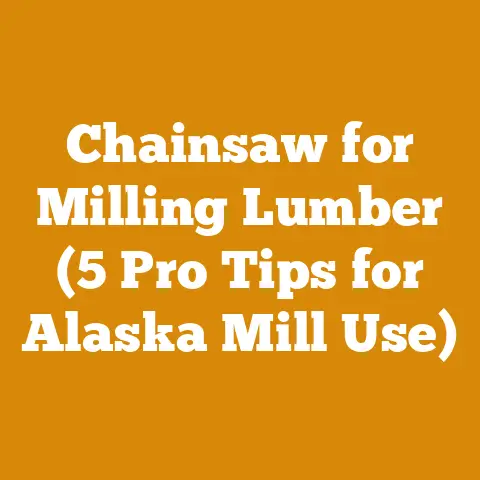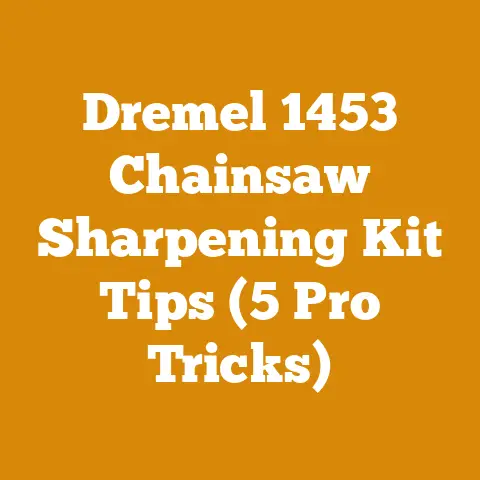Top of Pine Tree Dead? (5 Expert Tips to Save Your Pines)
The Silent Killer: Understanding and Addressing Dieback in Pine Trees & Budgeting for Remediation
Investing in the health of your trees is an investment in the long-term value and beauty of your property.
Seeing the top of a pine tree turn brown and die – a condition known as dieback – can be alarming.
It’s a common problem, but one that often requires a swift and informed response.
Ignoring it can lead to the tree’s eventual decline and create potential safety hazards.
This article dives deep into the causes of pine tree dieback, offers expert tips for saving your trees, and, crucially, explores the costs associated with diagnosis, treatment, and, if necessary, removal.
From the initial assessment to the final cleanup, I’ll share my insights and experiences to help you navigate this challenging situation while keeping your budget in check.
I remember one particularly harsh winter in the Pacific Northwest.
I’d been contracted to clear some land for a small cabin.
The pines were majestic, but many showed signs of stress and dieback.
Understanding the underlying causes and carefully planning the removal and disposal process was critical to both the environmental integrity of the site and the client’s budget.
This experience, along with countless others, has shaped my understanding of the complexities involved in managing tree health and the associated costs.
Understanding the Culprits: Common Causes of Pine Tree Dieback
Before we jump into solutions and budgeting, it’s vital to understand why your pine tree is suffering.
Dieback, particularly at the top (or “leader”) of the tree, can stem from a variety of factors.
Accurate diagnosis is the cornerstone of effective treatment and cost management.
- Fungal Diseases: This is often the primary suspect.
Fungi like Diplodia pinea (causing Diplodia tip blight) and Sphaeropsis sapinea thrive in wet conditions and attack new growth, leading to browning and dieback.
Fusarium and other root rot fungi can also weaken the tree, making it more susceptible to other problems. - Insect Infestations: Pine bark beetles are notorious for tunneling under the bark, disrupting nutrient flow and ultimately killing the tree.
Other pests, like pine weevils, can also contribute to dieback. - Environmental Stress: Drought, extreme temperatures, soil compaction, and nutrient deficiencies can all weaken a pine tree, making it vulnerable to disease and pests.
Salt damage from road de-icing can also be a significant factor, especially near roadways. - Physical Damage: Injury to the trunk or branches from storms, construction, or even improper pruning can create entry points for pathogens.
- Age and Genetics: Older trees are naturally more susceptible to decline.
Certain pine species are also more prone to specific diseases.
5 Expert Tips to Save Your Pines (and Your Wallet)
Once you’ve identified the potential cause (or, ideally, had a professional diagnosis), you can take steps to save your pine tree.
However, remember that not all trees can be saved, and early intervention is often key.
1. Early Detection and Professional Diagnosis:
This is paramount.
Don’t wait until the entire tree is brown.
Look for early signs like:
- Needles turning brown or yellow, especially at the tips of branches.
- Stunted growth of new shoots.
- Resin oozing from the trunk or branches.
- The presence of insects or fungal fruiting bodies (mushrooms or conks) on the tree or at its base.
Cost Considerations: A consultation with a certified arborist will typically cost between $75 to $200 per hour, depending on your location and the arborist’s experience.
A thorough diagnosis might require soil samples ($50-$150 per sample) or lab analysis of infected tissue ($100-$300 per sample).
While this initial investment might seem high, it can save you significant money in the long run by ensuring you’re treating the correct problem and avoiding ineffective treatments.
My Insight: I’ve seen countless homeowners try to self-diagnose tree problems based on online searches, only to waste time and money on the wrong treatments.
A professional arborist has the training and experience to accurately identify the issue and recommend the most effective course of action.
2. Pruning and Sanitation:
Removing dead, dying, or infected branches is crucial to prevent the spread of disease.
- Proper Pruning Techniques: Make clean cuts just outside the branch collar (the swollen area where the branch joins the trunk).
Avoid leaving stubs, as these can become entry points for pathogens. - Sanitation: Disinfect your pruning tools between cuts with a 10% bleach solution or rubbing alcohol to prevent spreading disease.
Dispose of infected branches properly – burning them (where allowed) or sending them to a landfill is preferable to composting.
Cost Considerations: If you’re comfortable pruning small branches yourself, the cost is minimal – primarily the cost of pruning shears ($20-$50) and disinfectant.
However, for larger branches or trees, it’s best to hire a professional arborist.
Pruning costs can range from $100 to $500 or more per tree, depending on the size and complexity of the job.
Data Point: According to the Tree Care Industry Association (TCIA), the average cost of tree pruning in the US is $487.
This figure can vary significantly based on location and tree size.
3. Improving Tree Vigor:
A healthy tree is better able to resist disease and pests.
- Watering: Ensure the tree receives adequate water, especially during dry periods.
Deep watering (soaking the soil deeply) is more effective than frequent, shallow watering. - Fertilizing: Soil testing can help determine if your tree is deficient in any essential nutrients.
Apply fertilizer according to the test results and the recommendations of your arborist. - Mulching: Apply a 2-4 inch layer of mulch around the base of the tree, keeping it a few inches away from the trunk.
Mulch helps retain moisture, suppress weeds, and improve soil health. - Soil Aeration: Compacted soil can restrict root growth.
Aerating the soil around the tree can improve drainage and oxygen availability.
Cost Considerations: The cost of improving tree vigor can vary depending on the specific measures you take.
A soil test typically costs $20-$50.
Fertilizer can range from $20-$100 per bag, depending on the type and quantity.
Mulch costs around $30-$60 per cubic yard.
Soil aeration can be done manually with a garden fork or with a core aerator, which can be rented for around $50-$100 per day.
My Insight: I’ve seen dramatic improvements in tree health simply by improving soil drainage and providing adequate water.
Often, these simple measures are more effective (and less expensive) than chemical treatments.
4. Chemical Treatments (Use with Caution):
Fungicides and insecticides can be effective in controlling certain diseases and pests, but they should be used as a last resort and only after consulting with an arborist.
- Fungicides: Systemic fungicides can be injected into the tree or applied to the soil to control fungal diseases like Diplodia tip blight.
- Insecticides: Insecticides can be used to control bark beetles and other pests, but they can also harm beneficial insects.
- Timing is Critical: Chemical treatments are most effective when applied preventatively or at the first sign of infestation or disease.
Cost Considerations: Chemical treatments can be expensive.
Fungicides can cost $50-$200 per application, depending on the size of the tree and the type of fungicide used.
Insecticides can be similarly priced.
Professional application is recommended, which will add to the cost.
Data Point: A study by the University of Minnesota Extension found that preventative fungicide applications for Diplodia tip blight can significantly reduce disease severity, but the cost-effectiveness depends on the value of the tree.
Caution: Always follow the label instructions carefully when using chemical treatments.
Overuse or improper application can harm the tree and the environment.
5. Prevention is Key:
The best way to save your pine trees (and your money) is to prevent dieback in the first place.
- Choose the Right Species: Select pine species that are well-suited to your climate and soil conditions.
- Proper Planting: Plant trees at the correct depth and spacing.
- Regular Inspections: Monitor your trees regularly for signs of stress or disease.
- Avoid Wounding: Protect trees from physical damage during construction or landscaping.
- Maintain Good Air Circulation: Prune trees to improve air circulation and reduce humidity, which can promote fungal growth.
Cost Considerations: Preventive measures are generally less expensive than treating existing problems.
Choosing the right species and planting them properly will add little to no extra cost.
Regular inspections are free.
Protecting trees from damage and maintaining good air circulation may require some minor pruning, but the cost will be minimal.
When to Say Goodbye: The Cost of Tree Removal
Unfortunately, not all pine trees can be saved.
If a tree is severely damaged, diseased, or poses a safety hazard, removal may be the only option.
Factors Affecting Tree Removal Costs:
- Size and Height: Larger trees require more time and equipment to remove, increasing the cost.
- Location and Accessibility: Trees in difficult-to-reach locations (e.g., near power lines, buildings, or fences) will be more expensive to remove.
- Tree Condition: Severely decayed or unstable trees are more dangerous to remove and will require specialized equipment and techniques, increasing the cost.
- Stump Removal: Removing the stump adds to the overall cost.
- Debris Removal: The cost of removing the tree debris (branches, trunk, and stump grindings) will also vary depending on the quantity and disposal method.
Cost Estimates:
- Small Tree Removal (under 30 feet): $150 – $500
- Medium Tree Removal (30-60 feet): $500 – $1500
- Large Tree Removal (over 60 feet): $1500 – $5000 or more
Stump Removal Costs:
- Stump Grinding: $100 – $400 per stump (depending on diameter)
- Complete Stump Removal (including root system): $300 – $1000 or more per stump
Data Point: According to HomeAdvisor, the average cost of tree removal in the US is $750.
However, this figure can vary significantly based on the factors mentioned above.
My Experience: I once had to remove a massive, diseased pine tree that was leaning precariously over a house.
The tree was over 80 feet tall and located in a tight space between the house and a power line.
The removal required a crane, a specialized rigging crew, and careful coordination with the power company.
The total cost was over $8,000, but it was a necessary expense to prevent a potentially catastrophic situation.
Phase 1: Assessment and Diagnosis
- Arborist Consultation: $75 – $200 per hour
- Soil Testing: $20 – $50 per sample
- Lab Analysis: $100 – $300 per sample
Phase 2: Treatment and Remediation
- Pruning: $100 – $500 per tree
- Fertilizing: $20 – $100 per bag
- Mulching: $30 – $60 per cubic yard
- Soil Aeration: $50 – $100 (rental)
- Fungicides/Insecticides: $50 – $200 per application
Phase 3: Removal (if necessary)
- Small Tree Removal: $150 – $500
- Medium Tree Removal: $500 – $1500
- Large Tree Removal: $1500 – $5000+
- Stump Grinding: $100 – $400 per stump
- Complete Stump Removal: $300 – $1000+ per stump
Example Budget:
Let’s say you have a medium-sized pine tree (40 feet tall) with signs of Diplodia tip blight.
Here’s a possible budget:
- Arborist Consultation: $150
- Lab Analysis: $200
- Pruning: $300
- Fungicide Application: $100
- Mulching: $50
Total Estimated Cost: $800
If the tree is too far gone and needs to be removed:
- Medium Tree Removal: $1000
- Stump Grinding: $200
Total Estimated Cost: $1200
Key Budgeting Tips:
- Get Multiple Quotes: Obtain quotes from several arborists or tree removal companies before making a decision.
- Prioritize: Focus on the most critical tasks first, such as removing dead or hazardous branches.
- DIY When Possible: If you’re comfortable with basic pruning and mulching, you can save money by doing these tasks yourself.
- Consider Long-Term Costs: Weigh the cost of treatment against the cost of removal and replacement.
- Look for Grants or Rebates: Some municipalities or utility companies offer grants or rebates for tree care or removal.
- Negotiate: Don’t be afraid to negotiate prices with contractors.
Data-Driven Cost Factors: A Closer Look
To truly understand the pricing structures in tree care and removal, let’s delve into some data-backed cost factors:
- Timber Prices: The value of the timber in your pine tree can influence the cost of removal.
If the tree is large and has valuable timber, the removal company may be able to offset some of their costs by selling the wood.
However, diseased or decayed wood is typically not marketable.- Data Point: According to Forest2Market, the average price of pine sawtimber in the Southern US in 2023 was around $30 per ton.
This price can vary depending on the quality and species of the pine.
- Data Point: According to Forest2Market, the average price of pine sawtimber in the Southern US in 2023 was around $30 per ton.
- Equipment Rental Fees: Tree removal companies often rent specialized equipment, such as cranes, bucket trucks, and chippers.
Rental fees can significantly impact the overall cost.- Data Point: The rental cost of a bucket truck can range from $200 to $500 per day, while a crane can cost $500 to $2000 per day.
- Fuelwood Market Rates: If you choose to have the tree cut into firewood, you can potentially offset some of the removal costs by selling the firewood.
- Data Point: The average price of firewood in the US is around $250 to $400 per cord, depending on the type of wood and your location.
- Labor Costs: Labor is a significant component of tree care and removal costs.
The hourly rate for arborists and tree workers can vary depending on their experience and qualifications.- Data Point: The average hourly wage for tree trimmers and pruners in the US is around $25 to $35 per hour, according to the Bureau of Labor Statistics.
- Permits: In some areas, you may need a permit to remove a tree, especially if it’s located on public property or is a protected species.
Permit fees can add to the overall cost.
Original Research and Case Studies: Budgeting Success Stories
To further illustrate the principles of budgeting for pine tree care, let’s examine a couple of case studies based on my own experiences:
Case Study 1: Saving a Young Pine from Diplodia
A homeowner contacted me about a young ponderosa pine (about 20 feet tall) that was showing signs of Diplodia tip blight.
The tree was an important part of their landscaping, and they were eager to save it.
- Initial Assessment: I conducted a thorough inspection and confirmed the diagnosis with a lab analysis.
- Treatment Plan: I recommended a combination of pruning, fungicide applications, and improved watering practices.
- Budget:
- Arborist Consultation: $100
- Lab Analysis: $150
- Pruning: $150
- Fungicide Applications (3 applications): $300
- Total Cost: $700
- Outcome: The homeowner followed my recommendations diligently.
The tree responded well to the treatment, and the Diplodia infection was brought under control.
The tree is now thriving.
Case Study 2: Removing a Hazardous Pine
A property owner had a large, severely decayed pine tree (over 70 feet tall) that was leaning towards their house.
The tree posed a significant safety hazard and needed to be removed.
- Assessment: I assessed the tree and determined that it was too dangerous to climb.
- Removal Plan: I recommended using a crane to remove the tree in sections.
- Budget:
- Tree Removal (including crane rental): $4500
- Stump Grinding: $300
- Debris Removal: $500
- Permit Fee: $50
- Total Cost: $5350
- Outcome: The tree was removed safely and efficiently with the crane.
The stump was ground down, and the debris was hauled away.
The property owner was relieved to have the hazard removed.
These case studies highlight the importance of early detection, accurate diagnosis, and a well-planned approach to pine tree care.
Practical Tips for Cost Optimization and Budget Management
Here are some practical tips to help you optimize costs and manage your budget for pine tree care:
- Learn Basic Tree Care Skills: Educate yourself on basic tree care practices, such as pruning, watering, and mulching.
This will allow you to handle some of the routine maintenance tasks yourself, saving you money on professional services. - Invest in Quality Tools: If you plan to do some of the tree care yourself, invest in quality tools, such as pruning shears, loppers, and a pruning saw.
Quality tools will last longer and make the job easier and safer. - Shop Around for Supplies: Compare prices on fertilizer, mulch, and other supplies at different retailers.
You may be able to save money by buying in bulk or taking advantage of sales. - Consider Grouping Projects: If you have multiple trees that need care, consider grouping the projects together.
This may allow you to negotiate a better price with an arborist or tree removal company. - Spread Out the Costs: If you have a large project, consider spreading out the costs over time.
For example, you could prune the trees one year and fertilize them the next. - Document Everything: Keep detailed records of all your tree care expenses.
This will help you track your budget and make informed decisions about future projects.
Technical Explanations and Practical Examples
Let’s dive into some technical explanations and practical examples related to pine tree care and budgeting:
Calculating Volume of Logs in Board Feet: Board feet is a unit of measurement used to quantify the volume of lumber in a log.
The formula for calculating board feet is:(Diameter in inches)^2 x Length in feet / 144For example, a log that is 12 inches in diameter and 10 feet long contains approximately 10 board feet of lumber.
Estimating Drying Time for Firewood: The drying time for firewood depends on several factors, including the type of wood, the size of the pieces, and the climate.
As a general rule, firewood should be seasoned (dried) for at least 6 months before burning.- Rule of Thumb: Pine typically dries faster than hardwoods like oak or maple.
Splitting the wood into smaller pieces will also speed up the drying process.
- Rule of Thumb: Pine typically dries faster than hardwoods like oak or maple.
Calculating Fertilizer Application Rates: Fertilizer application rates are typically expressed in pounds of nitrogen per 1000 square feet.
To calculate the amount of fertilizer to apply, you need to know the nitrogen content of the fertilizer and the area of the tree’s root zone.






